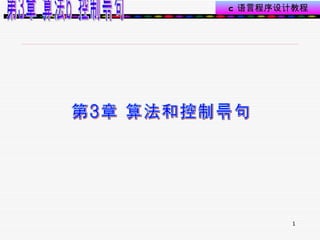Contenu connexe
Similaire à 第3章算法与控制语句 (20)
第3章算法与控制语句
- 24. 修饰符: 确定数据输出的宽度、精度、小数位数、对齐方式 在 e,f,g 前,指定输出精度为 double 型 在 d,o,x,u 前,指定输出精度为 long 型 l 在八进制和十六进制数前显示前导 0 , 0x # 输出数值时指定左面不使用的空位置自动填 0 0 指定在有符号数的正数前显示正号 (+) + 输出数据在域内左对齐(缺省右对齐 ) - 对实数 , 指定小数点后位数 ( 四舍五入 ) 对字符串 , 指定实际输出位数 .n 输出数据域宽 , 数据长度 <m, 左补空格 ; 否则按实际输出 M 含义 修饰符
- 26. 程序运行结果: 3 4 y=3 , z=4 1234,1234 123.456001,123.456001, 123.5,123.46,1.23e+002 123.456000 a Hello,world! Hello,world! Hello Hello Hel
- 32. 例 int x; char ch; scanf(“%d”,&x); ch=getchar(); printf(“x=%d,ch=%d”,x,ch); 执行: 123 输出: x=123,ch=10 例 int x; char ch; scanf(“%d”,&x); scanf(“ %c”,&ch); 或 scanf(“%*c%c”,&ch);
- 49. if(weekday==0) printf("%2d",date); else if(weekday==1) printf("%7d",date); else if(weekday==2) printf("%12d",date); else if(weekday==3) printf("%17d",date); else if(weekday==4) printf("%22d",date); else if(weekday==5) printf("%27d",date); else printf("%32d",date); return 0; } #include <stdio.h> int main() { int date,weekday,original_date=3; scanf("%d",&date); if(date<1||date>31) { printf(" 数据输入错误 !"); return 1; } weekday=(date+original_date-1)%7; printf("2010 年 12 月日历 "); printf("----------------------------------"); printf("Sun Mon Tue Wen Thr Fri Sta "); printf("----------------------------------");
- 51. 3.3.4 条件语句的嵌套 嵌套具有 else 子句的 if 语句 if ( 表达式 1) if ( 表达式 2) 语句序列 1 else 语句序列 2 嵌套不含 else 子句的 if 语句 if ( 表达式 1) 语句序列 1 else if ( 表达式 2) 语句序列 2 一般形式 if ( 表达式 1) if ( 表达式 2) 语句序列 1 else 语句序列 2 else if( 表达式 3) 语句序列 3 else 语句序列 4
- 53. 例: if (a==b) if(b==c) printf(“a==b==c”); else printf(“a!=b”); 修改: if (a==b) { if(b==c) printf(“a==b==c”); } else printf(“a!=b”); 实现 if ~ else 正确配对方法:加 { }
- 60. #include <stdio.h> #include <stdlib.h> int main() { int score; scanf("%d",&score); if(score<0||score>100 ) { printf(" 输入数据错误 "); exit(0); } switch( score/10 ) { case 10: case 9:printf(" 优秀 ");break; case 8:printf(" 良好 ");break; case 7:printf(" 中等 ");break; case 6:printf(" 及格 ");break; default:printf(" 不及格 "):break } return 0; }
- 63. #include<stdio.h> int main() { int year; double money,rate,total; printf(" 输入存款和存期 :"); scanf("%lf %d",&money,&year); switch(year) { case 1:rate=0.0225;break; case 2:rate=0.0279;break; case 3:rate=0.0333;break; case 5:rate=0.0360;break; case 8:rate=0.0414;break; default:rate=0.0;printf(" 输入的存期错误 !");break; } total=money+money*rate*year; printf(" 从银行获得的总金额为: %.2lf",total); return 0; }
- 74. #include<stdio.h> #include<stdlib.h> int main() { int i,sum=0,p=1,n; scanf("%d",&n); if(n<0) { printf(" 负数没有阶乘! "); exit(0); } for(i=1;i<=n;i++) { p=p*i; sum=sum+p; } printf(" 阶乘的和为: %d",sum); return 0; } 例 3.30 :计算
- 80. #include <stdio.h> int main() { int i,j; printf("---------------------------------------"); for(i=1;i<10;i++) printf("%4d",i); printf("---------------------------------------"); for(i=1;i<10;i++) /* 外循环 */ { printf("%d",i); for(j=1;j<10;j++) /* 内循环 */ printf("%4d",i*j); printf(""); } printf("---------------------------------------"); return 0; }
- 89. #include<stdio.h> int main() { int i,f1=1,f2=1; for(i=1;i<=20;i++) { printf("%12d %12d",f1,f2); if(i%2==0) /* 每行输出 4 个数 */ printf(""); f1=f1+f2; f2=f2+f1; } return 0; }
